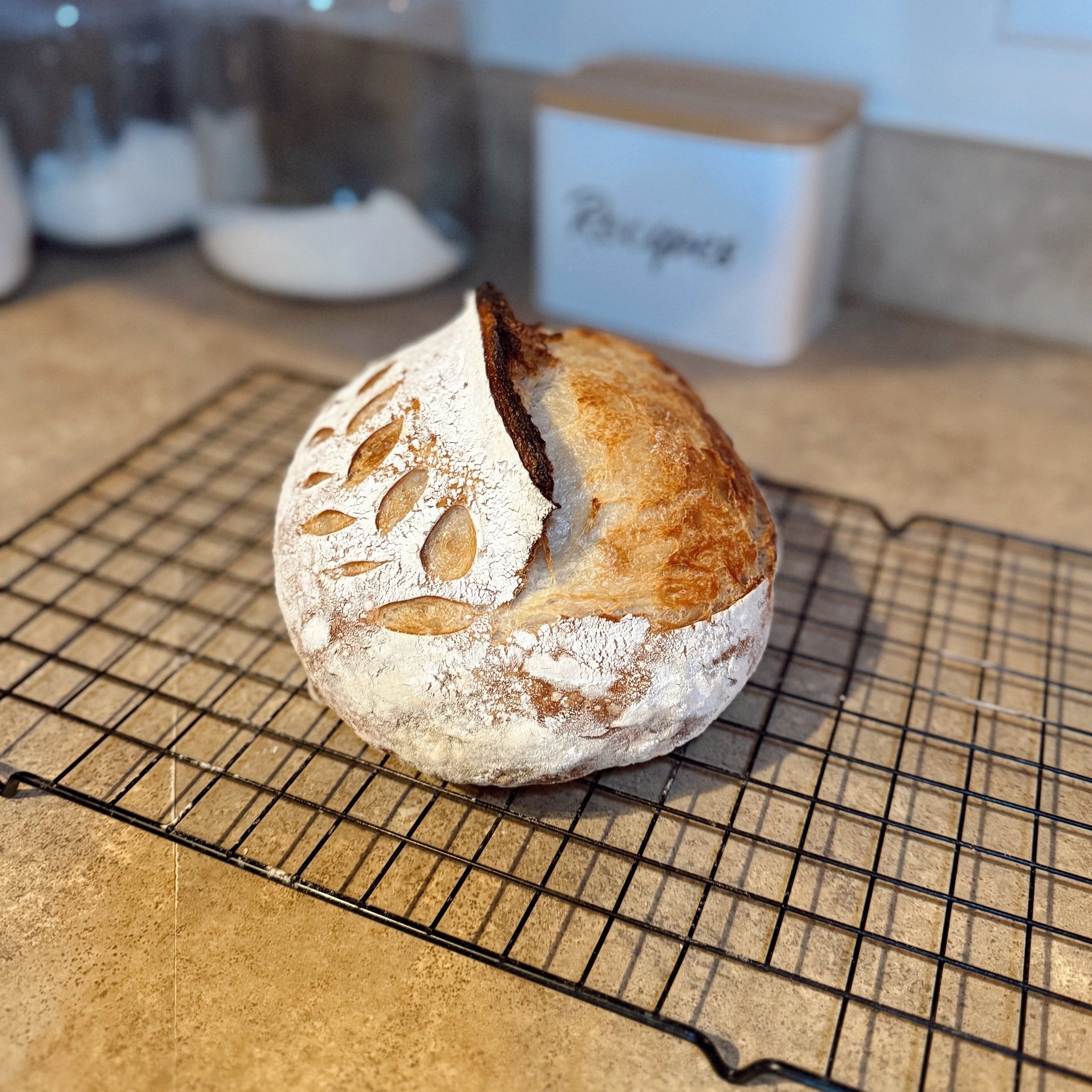Rustic Sourdough Loaf Recipe
Ingredients:
350g warm water
100g active starter
500g bread flour
10g salt
Instructions:
1. Prepare the Dough:
In a large mixing bowl, combine 350g of warm water with 100g of active sourdough starter. Stir gently to dissolve the starter. The starter should float in water if it’s active and ready for baking.
Add 500g of bread flour to the bowl. Mix until no dry flour pockets remain. Using your hands works best to ensure thorough mixing.
2. Rest the Dough (Autolyse):
Scrape down the sides of the bowl to tidy it up, then cover the bowl with a tea towel. Let the dough rest at room temperature for 1 hour.
3. Add Salt and Stretch & Fold (Round 1):
Sprinkle 10g of sea salt evenly over the dough. Wet your hands to prevent sticking and gently stretch one side of the dough upward until you feel resistance. Fold it over the top of the dough.
Rotate the bowl slightly and repeat the process on all sides of the dough. Perform 8 stretch-and-fold movements (two full rotations around the bowl). Cover and rest for 30 minutes.
4. Continue Stretch & Fold (Rounds 2–4):
Repeat the stretch-and-fold process every 30 minutes, reducing the folds as the dough tightens and gluten develops. By the final round (3–4 total sets), the dough should feel elastic and hold its shape.
Cover the bowl after each stretch and fold.
5. Bulk Fermentation:
After the final stretch and fold, cover the dough and leave it to ferment at room temperature for 6–8 hours or overnight.
The dough is ready for the next step when it has doubled in size, has visible bubbles, jiggles slightly when the bowl is shaken, and releases cleanly from the bowl when inverted.
6. Pre-Shape the Dough:
Turn the dough out onto a lightly floured work surface. Gently stretch it into a rectangular shape, taking care not to deflate too many bubbles.
Perform an envelope fold: fold one short end into the center, then fold the other short end over the first. Rotate the dough 90° and roll it into a log. Pinch and tuck the ends underneath, creating surface tension by gently pulling the dough back toward you.
7. Bench Rest and Final Shaping:
Let the dough rest on the counter, seam side down, for 10–15 minutes. Repeat the shaping process to reinforce the structure, then place the dough seam-side up into a floured banneton or a tea towel-lined bowl. Cover and refrigerate for at least 4 hours or overnight for a cold proof.
8. Preheat the Oven:
Preheat your oven to 450°F (232°C) with your Dutch oven (lid on) inside for at least 30 minutes. For open baking, place a baking sheet and a separate pan for water inside the oven to preheat.
9. Scoring the Dough:
Remove the dough from the fridge and invert it onto a sheet of parchment paper. Score the top of the dough with a sharp blade or lame. Create simple expansion cuts or decorative patterns, depending on your preference.
10. Bake the Bread (Covered):
Place the dough into the preheated Dutch oven, cover with the lid, and bake for 25 minutes.
For open baking, carefully pour hot water into the preheated pan beneath the baking sheet (avoid splashing water on the oven glass to prevent shattering). Bake the dough on the baking sheet for 25 minutes.
11. Bake the Bread (Uncovered):
Remove the lid from the Dutch oven or the water pan from the oven, then bake for an additional 20 minutes. The bread should turn golden brown and develop a crisp crust.
12. Cool the Bread:
Transfer the finished loaf to a cooling rack and let it rest for at least 1 hour before slicing. This allows the interior to finish setting and prevents a gummy texture.

